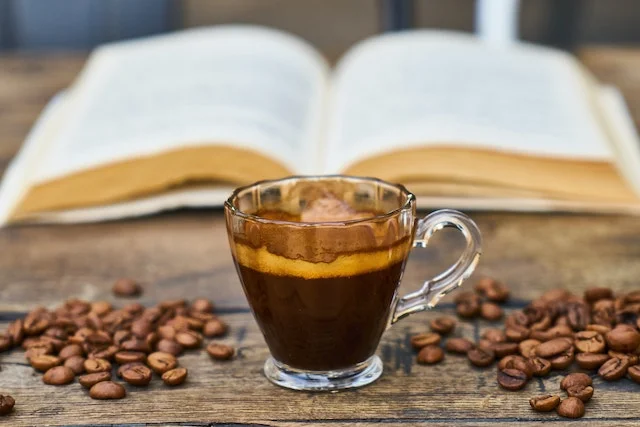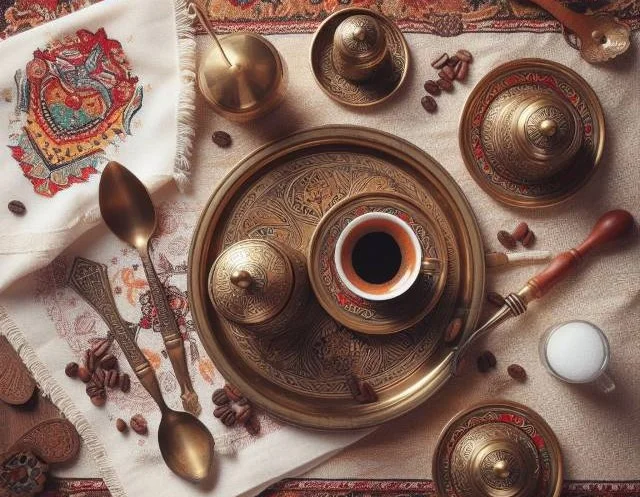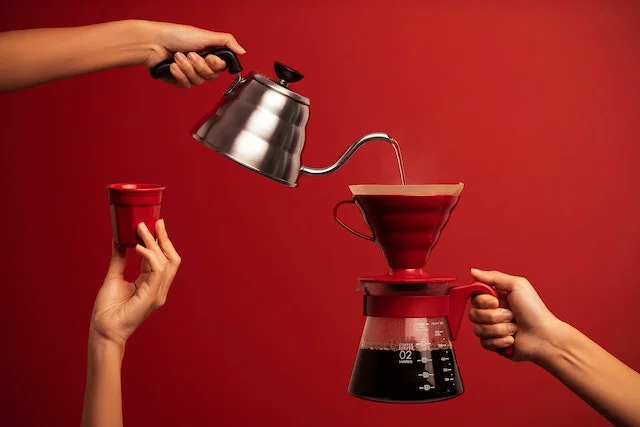Coffee Traditions and Cultures
What do you think of when you hear the word “coffee”? Perhaps your morning routine, a pick-me-up throughout the day, or a social experience with friends. Coffee has become a ubiquitous beverage worldwide, and it’s fascinating to explore how different cultures and traditions have shaped the way we enjoy it. From the rich espresso culture of Italy to the cozy Nordic fika, coffee has transcended borders and connected individuals worldwide. Let’s dive into the world of coffee traditions and cultures and discover how this beloved beverage brings people together.
Coffee Traditions and Cultures Key Takeaways
- Coffee has become a staple beverage worldwide.
- The way we enjoy coffee is shaped by different cultures and traditions.
- Coffee has the power to connect individuals across borders.
- Exploring coffee traditions and cultures can deepen our appreciation for this beloved beverage.
Italian Coffee Culture

Let’s talk about Italy and coffee. Italy is one of the most famous coffee countries around. Their classic espresso shots and foamy cappuccinos have a long history and unique traditions passed down through generations.
One key part of Italian coffee culture? Making the perfect espresso shot. Italians take espresso seriously. Their cafes use high-quality beans and skilled baristas who can pull the ideal shot. A real Italian espresso should have a consistent creamy foam on top. It should be thick and syrupy with a bold, rich flavor.
Here’s another Italian coffee culture fact you may not know. It’s common to stand at the counter and drink your espresso or cappuccino quickly. Then you’re back on the go. This shows the fast pace of Italian life. People are always moving and don’t have time to sit and linger over coffee.
Of course, we can’t forget the classic Italian cappuccino. Here’s an Italian coffee rule: Don’t order cappuccinos after 11am. The milk is considered too heavy to digest later in the day. Blend in by ordering a macchiato instead. It’s a shot of espresso with just a splash of milk.
Overall, Italian coffee culture is complex yet fascinating. It continues to evolve and thrive today. Sip a classic espresso or frothy cappuccino and taste Italy!
Turkish Coffee Traditions

When we talk coffee culture, Turkey holds a special place worldwide. Turkish coffee is unique for its brewing method. It’s been part of Turkish social gatherings for centuries.
Preparing Turkish coffee takes time and care. The beans are ground super fine and then mixed with water. It’s heated in a traditional Turkish pot called a cezve over medium heat. Then it’s poured into tiny cups without filtering out the grounds.
But Turkish coffee is more than a drink. It’s key to Turkish hospitality and culture. Coffee is served with Turkish delight candy and water to cleanse your palate. It’s customary to offer coffee to guests as a sign of respect.
Turkish coffee also has a fortune-telling ritual. Once you finish your coffee, the grounds in your cup are used to tell your fortune. The cup flips over onto the saucer. The shapes the grounds make are interpreted by a fortune teller.
Experience the richness of Turkish coffee traditions when you join in Turkish social gatherings. Appreciate coffee’s significance in Turkish culture.
Ethiopian Coffee Ceremony
Ethiopia is considered the birthplace of coffee. The Ethiopian coffee ceremony is an important cultural tradition there. It’s a time-honored way of honoring guests and celebrating special occasions like births, weddings, and festivals.
Typically a respected female community member leads the ceremony. She roasts the beans over hot coals. Then she grounds them by hand using a mortar and pestle. The fresh grounds brew in a traditional clay pot called a jebena. It sits on hot coals or a special apparatus.
The coffee brews slowly to let the bold, rich flavors develop. Once ready, it’s poured into tiny cups and served with snacks like popcorn. There’s often traditional music and dancing too.
One unique part of the ceremony? Fortune telling with the coffee grounds. After serving the coffee, the hostess takes the empty cups. She flips them upside down on a tray. Then she reads the patterns the drying grounds make to predict the future.
The ceremony is more than brewing and serving coffee. It’s a time-honored social tradition that celebrates Ethiopia’s rich cultural heritage.
French Coffee Culture
Let’s talk French coffee culture! France is known for charming coffee ways. Coffee is savored slowly and enjoyed socially there. The French take pride in their coffee. You’ll often see people at cafés for hours with a cup or two. They watch people while relaxing.
French coffee culture started in the 1600s when Paris got its first coffee houses. These cafes quickly became places for artists and intellectuals to meet. Soon they were the center of Paris’s social life.
The most popular French coffee drink is café au lait. It’s equal parts coffee and milk served in a big bowl-like cup. Another common one is café crème. It’s like a cappuccino but with less foam.
French coffee culture is about the whole experience. The French take their time enjoying their coffee. They often pair it with a croissant or other tasty pastry. The café is where people go to socialize, relax, and savor life’s simple pleasures.
French Café Culture
French café culture is just as important as the coffee culture. Cafés are more than places to get coffee. They’re a way of life in France! Cafés are where people go to socialize, discuss politics, and hear the latest gossip.
In the past, cafés were only for men. But now they’re open to all. The French café scene has diversified. It now includes cafés with artisanal coffee and tourist-friendly cafés.
The French have a special way of serving coffee too. It uses a tiny spoon and sugar cube. The spoon slowly melts the sugar into the coffee. This makes a delightful aroma and taste.
French Coffeehouses
The French take coffee seriously. You can see this in the many coffeehouses throughout France. They come in all types and sizes – from cozy corners to grand, fancy buildings.
French coffeehouses aren’t just places for coffee. They’re also places to indulge in delicious pastries and desserts. Many have an on-site pastry chef. It’s common to enjoy a croissant or éclair with your coffee.
French coffee culture is about enjoying the simple pleasures in life. Whether people watching at a café or indulging in a croissant at a coffeehouse, coffee is integral to French culture.
Japanese Coffee Culture
Japan has a unique and meticulous coffee culture globally recognized. Japanese people have made coffee brewing and drinking an art form. They emphasize pour-over coffee and latte art. The Japanese coffee industry values precision, quality, and detail in every cup.
Japanese coffee shops are known for their calm, relaxing feel. They’re designed to promote comfort and intimacy. Many have low tables, floor seating, or chairs. Coffee shops are also popular for business meetings, dates, or just relaxing.
The Art of Pour-Over Coffee

Pour-over coffee is popular in Japan. It involves steadily pouring hot water over coffee grounds. This extracts the beans’ full flavor. The process takes several minutes. Baristas often pour in circles for even saturation. This makes a nuanced, bright, complex cup of coffee.
The Art of Latte Art
Latte art is another popular coffee form in Japan. It involves making designs with the milk foam on lattes. Baristas use techniques like freehand pouring or stencils to create intricate designs. These include hearts, leaves, and cartoons. Latte art is aesthetically pleasing and shows the barista’s skill.
Next time you’re in a Japanese coffee shop, appreciate the careful coffee preparation. Whether a pour-over or a latte with beautiful art, you’re experiencing unique Japanese coffee culture.
Scandinavian Coffee Culture

Coffee has a unique role in Scandinavia. It’s not just a drink, but a lifestyle. The “fika” concept is ingrained in Scandinavian culture. People take breaks to enjoy coffee and pastries with loved ones.
Scandinavian coffee culture emphasizes quality, simplicity, and community. The coffee is strong and bold, in small cups, with treats like cinnamon buns. But what makes it special is the focus on bonding. Coffee breaks are for connecting with others whether at cafés or at home.
Scandinavia is also known for innovative roasting like Nordic roasting. This involves roasting beans at lower temps for longer. It produces a smoother, less bitter taste.
If you visit Scandinavia, be sure to do a fika. Discover the warmth and community of this unique coffee culture.
Vietnamese Coffee Culture
Experience the vibrant, bold flavors of Vietnamese coffee culture. Vietnamese coffee is unique for using sweetened condensed milk and a traditional phin filter. The phin sits on the cup, dripping hot water through the grounds. This makes a strong, flavorful coffee with a hint of sweetness.
Coffee plays an important role in Vietnamese culture, often enjoyed socially. The classic iced ca phe sua da with sweetened condensed milk is popular and found everywhere.
Discover the rich history and traditions of Vietnamese coffee culture. Try making ca phe sua da at home to fully experience Vietnam’s unique flavors.
Greek Coffee Traditions
Let’s talk Greek coffee culture! Coffee plays a big role in Greek social gatherings. It’s seen as a symbol of hospitality. Brewing Greek coffee takes time. The grounds slowly heat in a small copper pot called a briki. Then the coffee is served unfiltered in tiny cups.
The Greek coffee experience is more than the drink. It’s also the ritual around it. Greeks often enjoy coffee with a small, sweet treat like loukoumades or baklava. A common ritual is reading the coffee grounds to predict the future, called tasseography. You turn the cup over and interpret the ground patterns left behind.
Overall, Greek coffee represents community and hospitality in Greek culture. It captures the warm, welcoming nature of Greek people.
Conclusion
From Italy’s rich espresso culture to Ethiopia’s intricate coffee ceremony, coffee traditions have shaped communities for centuries. Each country enjoys this beloved drink uniquely, showing coffee’s global power to connect people.
Explore these coffee cultures to appreciate coffee’s worldwide significance. Whether you’re savoring French café au lait or Vietnamese ca phe sua da, you’re partaking in a vibrant global tradition.
Coffee Traditions and Cultures Frequently Asked Questions
Coffee culture refers to the social and cultural aspects associated with the consumption of coffee. It includes the rituals, traditions, and practices surrounding coffee preparation, serving, and enjoyment.
Coffee holds significant cultural importance in various cultures around the world. It often symbolizes hospitality, socialization, and community bonding. Different cultures have their own unique coffee traditions and rituals that reflect their values and customs.
Espresso is a concentrated form of coffee that is brewed using high pressure and finely ground coffee beans. It has a rich flavor and a thick layer of crema on top. Regular coffee, on the other hand, is brewed by steeping coarser coffee grounds in hot water. It has a milder flavor and a lighter body.
The traditional Vietnamese coffee filter is called a phin. It consists of a small metal filter placed on top of a cup or glass. Ground coffee is added to the filter, and hot water is poured over it. The coffee slowly drips through the filter, resulting in a strong and bold cup of Vietnamese coffee.
Turkish coffee is known for its unique brewing method and strong flavor. It is made by boiling finely ground coffee beans in a cezve, a special pot, with water and sugar. The coffee is then served in small cups, and the grounds settle at the bottom. Traditionally, Turkish coffee is enjoyed slowly while engaging in conversation or fortune-telling using the coffee grounds.








